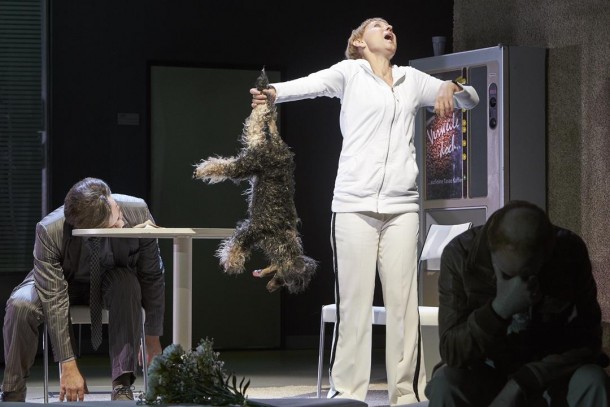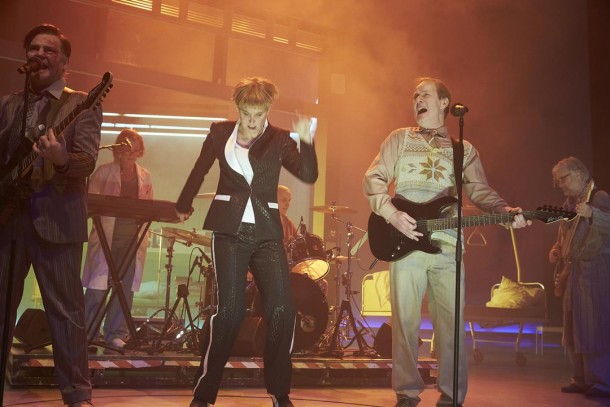Swedish director Linus Tunström’s new staging of the first part of Goethe’s Faust at the Staatsschauspiel Dresden insightfully moves the text into the twenty-first century. Much has been made of the director’s “outsider” status as a non-German director and the inevitable impact this would have on the interpretation of the national drama. Tunström admitted that Faust does not play a major role in the Swedish performance tradition, and, what’s more, Scandinavia does not adhere to the same classical canon of major texts that one finds in the repertoire of German-speaking theatres. The invitation arose after the Staatsschauspiel Intendant Wilfried Schulz and resident dramaturge Felicitas Zürcher saw Tunström’s horror-inflected, visually stunning Hamlet at the Uppsala Stadsteater, where he is Artistic Director and CEO. Tunström described the opportunity to direct the play in Dresden as an adventurous excursion. In Sweden, Tunström claims, audiences prefer concrete stories and conflicts. As a result, the director was more invested in finding a tangible locale for the play than in teasing out the more abstract or philosophical elements of the Faust-Mephisto duel (Männerzweikampf).
Any recent production of Faust in Germany and Austria has to compete with (and to some degree be measured against) the wild success of Nicholas Stemann’s postdramatic interpretation, a co-production between Hamburg’s Thalia Theatre and the Salzburg Festival named the best production of 2011-12 by the leading journal Theater heute. Stemann played dynamically with multiple casting, postdramatic editing and aesthetics to produce a Faust that destabilized the text’s revered cultural status while simultaneously using it as a platform for insightful cultural critique. Tunström also pursued a reflexive assessment of the play that opened up entirely new readings of its contemporary relevance for audiences that have been trained to decipher between textual fidelity and directorial intervention and authorship. Setting the play in a hospital, Tunström offered multiple, contrasting and simultaneous figures to play Faust, including a surgeon (Hannelore Koch), a dying old man (Peter Pagel), a visitor carrying flowers (Torsten Ranft), and a man admitted to the ER with a head wound (Tom Quaas). A hospital is where life climaxes and crises are played out in a variety of forms; it is a setting where people meet across the social spectrum. Hospitals are rich spaces for social commentary, as seen in television dramas over the past thirty years—from General Hospital and ER to House and Nurse Jackie. The multiple Fausts are only connected through their interaction in the hospital space. Refreshingly, Tunström does not attempt to universally tie the philosophical questions raised by the eponymous character to a particular set of characteristics, social position, or gender. Consequently, this casting decision does not simply imply that Faust is an “everyman” (Alltagsmenschen), but rather demonstrates the unbounded applicability of Faust’s predicament, positioning the text as a curated field of stimuli.
While there is not the typical evocation of the metaphysical, there are a number of forces that posses the hospital building and the characters themselves. Clinical green, white, and grey are the dominant colors of the setting, which highlight the moral and physical sterility of the environment in which the Fausts are ensconced. Gretchen, a hospital cleaner, is constantly wiping down the flat surfaces of tables, coffee machines, and plexiglass walls, all threatened by the contamination of blood and other bodily fluids. The temptation Mephisto offers Faust is not so much for total metaphysical knowledge as for the pursuit of unhygienic or de-sterilized experience in the midst of a society obsessed by cleanliness, bodily purity, longevity, and physical perfection. Doctors, cleaners, and patients alike crave cigarettes with a sort of physical hunger. This desperation for toxicity in the face of officially sanctioned “good health” is at the heart of this production, which emphasizes our current age as one preoccupied with high performance and opposed to death and dying.
The adversarial relationship normally exacerbated by hubris between Faust and Mephisto (Rosa Enskat) is rendered playful and sexual; it is articulated largely through the silly humour of slapstick or more earnest play of live rock music. Mephisto (ein kleiner Teufel) is clever, naughty and devilish, a sinewy woman in a Nike tracksuit who gambles and prances nimbly across the stage, leaving a trail of tomfoolery if not evil in her wake. Starting out as a physiotherapist helping patients with gentle exercises as part of their recovery, she quickly overturns the notion of therapy and healing. In place of signing the contract, a needle is inserted into the arm of each Faust to provide a litre of blood that Mephisto drinks in several enthusiastic gulps. The witch (Mephisto’s Assistant) is hilariously rendered by Jan Maak, naked in a blonde wig with his genitals trapped out of sight between his legs. Although this image at first conjures up the infamous scene in Jonathon Demme’s The Silence of the Lambs (1991) when the transvestite serial killer Buffalo Bill assesses the seductiveness of his body in the mirror; the horror of the image is quickly dispelled when he places a talking skull at his crotch and uses a profusion of hospital refuse to produce a magic potion that the Fausts drink in order to trigger the love tragedy (Liebestragödie) with Gretchen. The sterile color pattern was paired with a soundscape produced by the choreographed repetition of actors sighing (at one point, even the audience is invited to join in) whose signification remains ambivalently pitched between relief, longing and distress, the very soundtrack of a hospital. The combination of sound and setting emphasised the underlying theme of making sense of one’s life in a secular world in which religious faith is replaced by an infatuation with health.
The real tragedy singularly reveals itself through the murder of Gretchen’s child. The production opens with a young girl sitting in the blue glow of a television, which prompted the man seated next to me to whisper, “Das Kind des Gretchens!” (That is Gretchen’s child!), thus foregrounding the decision to portray Gretchen as a 40-year-old single mother rather than a 14-year-old virgin. The consummation of Gretchen’s relationship with all four of the Fausts suggests sexual experience rather than naivety. The most visceral moment occurs when Gretchen finds her child poisoned by Mephisto. The display of mourning is as histrionic as in Greek tragedy and precipitates the possibility of a new ending to the play. While Goethe allowed Gretchen to ascend to heaven after she shows penitence for drowning her illegitimate child—Goethe famously replaced “she is condemned” (“Sie ist gerichtet”) with “she is saved” (“Sie ist gerettet”) in the Urfaust—Tunström simply has Gretchen leave the play altogether. As the set is broken down, revealing the enormous backstage of the theatre, Gretchen turns and walks offstage, leaving the multiple Fausts to play out their fantasies of pleasure, knowledge and power alone. As in Stemann’s earlier production, Gretchen refuses to merely function as an object of Faust’s narrative arc, though Tunström offers a more complete break from the text.
While the character Faust is spread outwards, the text is dramatically reduced, making the performance just two hours without an interval. This radically contrasts with the five-hour saga of many Faust stagings. In this condensed version, the Swedish “outsider” successfully produced one of Germany’s most frequently produced plays to offer a striking and relevant commentary on contemporary tensions between the sterility underpinning our health crazes and the pleasures of toxicity.
Bryce Lease is Senior Lecturer in the Drama Department at the Royal Holloway University of London. He has published extensively on the subjects of queer studies, theatre as social action, and politically engaged theatre in Poland and South Africa. He serves as book review editor for the Contemporary Theatre Review.
European Stages, vol. 5, no. 1 (Fall 2015)
Editorial Board:
Marvin Carlson, Senior Editor, Founder
Krystyna Illakowicz, Co-Editor
Dominika Laster, Co-Editor
Editorial Staff:
Elyse Singer, Managing Editor
Clio Unger, Editorial Assistant
Advisory Board:
Joshua Abrams
Christopher Balme
Maria Delgado
Allen Kuharsky
Bryce Lease
Jennifer Parker-Starbuck
Magda Romańska
Laurence Senelick
Daniele Vianello
Phyllis Zatlin
Table of Contents:
- Avignon the 69th Festival, July 4 to 25, 2015: Discovery Beyond The Classics by Philippa Wehle
- The 2015 Oslo International Festival at Black Box Theatre by Andrew Friedman
- The 2015 Theatertreffen by Marvin Carlson
- A Feminist Tuberculosis Melodrama: Melek by Theatre Painted Bird by Emre Erdem
- Nachtasyl at the Berliner Schaubühne: A Radical View of Gorky’s The Lower Depths by Beate Hein Bennett
- From Spectacular to Minimalist: Four Plays in Madrid, April 2015 by Phyllis Zatlin
- European productions at Montreal’s Transamériques Festival 2015 by Philippa Wehle
- Childish or Adult? Recent productions in Germany by Roy Kift
- Russian Drama in Finland by Pirkko Koski
- Troubling Cross-Currents in the Budapest National Theatre by Marvin Carlson
- Spain: Engaging with la Crisis Through Theatre by Maria Delgado
- Life and Death in the Emergency Room: Linus Tunström’s Faust 1 at the Staatsschauspiel Dresden by Bryce Lease
Martin E. Segal Theatre Center:
Frank Hentschker, Executive Director
Marvin Carlson, Director of Publications
Rebecca Sheahan, Managing Director
©2015 by Martin E. Segal Theatre Center
The Graduate Center CUNY Graduate Center
365 Fifth Avenue
New York NY 10016






